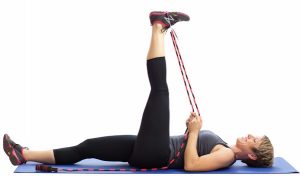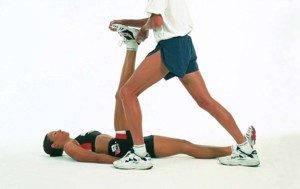What is PNF Stretching?
Proprioceptive Neuromuscular Facilitation, also known as PNF stretching, is a technique employed to improve muscle elasticity and range of motion. PNF is frequently used by therapists to restore functional range of motion and increase strength capabilities in patients who have sustained soft tissue damage or in post-surgery rehabilitation. It is found that consistent performance of PNF stretching and PNF stretching post-exercise may increase athletic performance by increasing range of motion. It is evident in literature that there are two types of techniques that can be utilized under PNF stretching.
The contract-relax method (CR) includes lengthening the targeted muscle and holding it in that position while the targeted muscle is contracted to its maximum isometrically for a period of time. A short period of relaxation and a passive stretch of the targeted muscle follows this initial contraction phase. The contract-relax-antagonist-contract method (CRAC) begins with the same procedure as the CR method. However, it takes a further step by contracting the antagonist muscle to the targeted muscle instead of passively stretching the targeted muscle.
How to Properly Perform a PNF Stretch:
Contract-Relax (CR) Method:
1) Stretch targeted muscle to the limit of normal range of motion. Contract the targeted muscle group for 5 – 10 seconds while a partner or immovable object such as a band applies sufficient resistance to inhibit movement of the muscle group.
2) Relax the targeted muscle group for 3 – 5 seconds.
3) Have your partner passively stretch the targeted muscle group by applying a controlled, deeper stretch for about 20 – 30 seconds into a greater range of motion.
4) Relax the muscle for approximately 30 seconds before repeating the above process 2 or 3 more times.
Contract-Relax-Antagonist-Contract (CRAC) Method:
1) Stretch targeted muscle to the limit of normal range of motion. Contract the targeted muscle group for 5 – 10 seconds while a partner or immovable object such as a band applies sufficient resistance to inhibit movement of the muscle group.
2) Relax the targeted muscle group for 3 – 5 seconds.
3) Contract the antagonist muscle (opposite to targeted muscle group) for 5 – 10 seconds.
4) After brief period of relaxation, have your partner passively stretch the targeted muscle group by applying a controlled, deeper stretch for about 20 – 30 seconds into a greater range of motion.
5) Relax the muscle for approximately 30 seconds before repeating the above process 2 or 3 more times.




